The Secret Muscle Holding Back Your Riding
For years I, like many riders, have struggled with my sitting trot. I took lunge lessons, I watched youtube videos, I rode with respected trainers, and still, I found it impossible to swing my hips naturally to follow my horse’s movement. I found it so frustrating that I seriously considered giving up my dream of riding at the upper levels, doubting my talent. Luckily for me, it was around that time that I entered massage school, and started receiving regular massages. My instructor found my back and hips incredibly tight and showed me a diagram on a poster we had in class. It showed a pair of muscles on either side of the spine that begin at the end of the mid back, fan out to the inner pelvis, and insert into the tops of each femur. “This is your iliopsoas,” she told me, “it’s your major hip flexor. Because you’ve been riding your whole life, and your hips are constantly flexing and extending to follow the horse, yours are very tight. I’m going to work on them for you.” After massaging me, she showed me a few stretches to do before I rode. The next day, and over the next months, I became more and more able to open my hips and master the elusive sitting trot. I thought to myself, all this time I have been so frustrated and blaming my riding ability, when I have just been held back by a small mechanical obstacle in my own body.
The iliopsoas is the largest and strongest deep hip muscle, extending from the twelfth thoracic vertebra, attaching along each lumbar vertebra down to the bowl of the pelvis, and wrapping under the top the femur. Iliopsoas actually refers to two separate muscles, the iliacus and psoas major, that join together in location and action. This muscle is the major hip flexor (drawing the thigh to the hip) and influences movement of the lower back.
Dysfunction of the iliopsoas is common. If this muscle is tight, it can pull the pelvis or low back out of alignment, restrict range of motion, and, often, become painful. If you have a tight iliopsoas, you may notice that you have trouble following your horse’s movement with your hips, constantly have a hollow back, or find that you favor one side of the saddle.
I recommend holding a deep lunge, pigeon pose, and frog pose to stretch your iliopsoas.
-Maija Luttinger, LMT
Want more content like this?
Equine Massage 101, the online equine massage course from Freely Forward Bodywork, is packed with valuable information, from massage techniques to stretches to ways to check for pain in your horse’s body and much more. Sign up to get started today!






